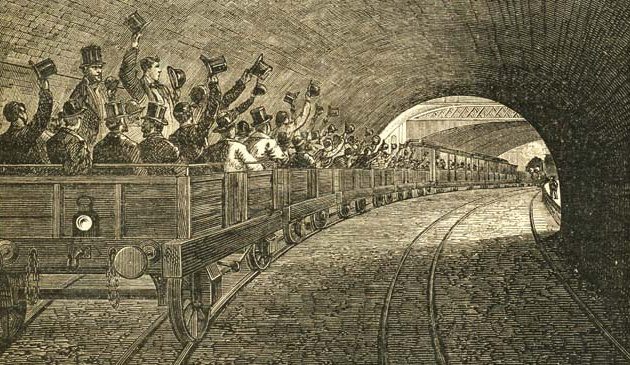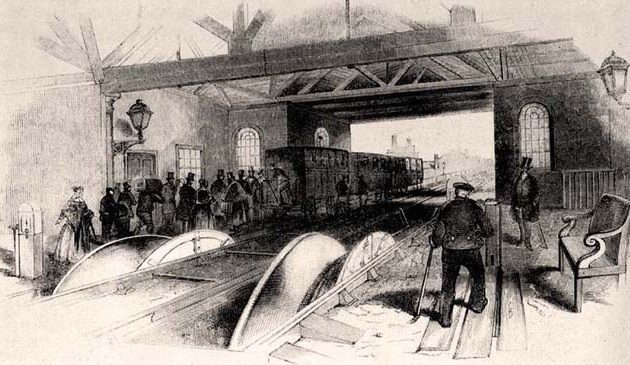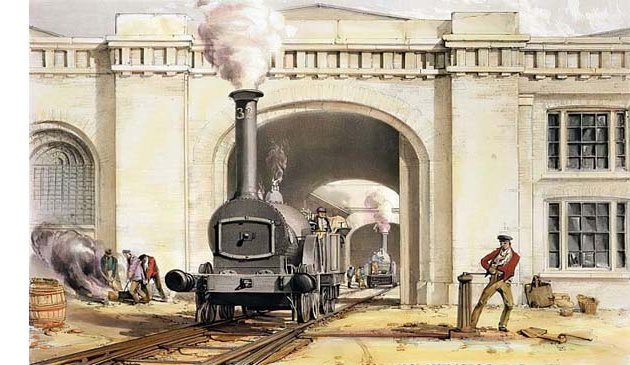The Metropolitan District railway – the creation of the Circle Line

Sloane Square station at the end of the 19th century. It was one of the original stations of the District Railway, opening on Christmas Eve 1868, and became a stop on the ‘inner circle’ upon its completion in 1884. Its construction was complicated by the underground River Westbourne crossing the line at that point. The river was carried over the station in a large pipe that can still be seen over the tracks today.
What we now know as the Circle Line that forms an underground loop around Central London was originally two separate railways, the Metropolitan and the District. The story of what was first known as the ‘inner circuit’ is one of both cooperation and conflict between the two railway companies.
The Metropolitan Railway opened in January 1863 between Paddington and Farringdon. Its steam trains ran underground connecting the railway termini at Paddington and King’s Cross, with several intermediate stations, and rapidly brought people to and from their place of work in the City of London.
What seems surprising from a modern point of view is that, as well as running its own services, the Metropolitan was also linked to main line railways, allowing trains from various companies to use the tracks. In that way, for example, a train of the Great Western Railway company from Slough could continue beyond Paddington and all the way under London to Farringdon.
The early success of the Metropolitan prompted proposals to Parliament for other underground railways in London, with many of similar routes to each other. The Parliamentary Select Committee on Metropolitan Railways recommended in 1863 an ‘inner circle’ to connect all London’s principle railway termini, including those stations serving south of London. This had become a possibility with the plan to develop new embankments along the Thames, within which it was possible to create a railway line.
One such route was proposed by John Fowler, chief engineer of the Metropolitan, which gained approval. Thus, the District Railway company received royal assent in July 1864 for a new line between South Kensington and Tower Hill, while at the same time two other Bills were passed for extensions to the Metropolitan. The District Railway, London’s second underground railway line, was closely associated with the Metropolitan, sharing directors, and with Fowler as chief engineer of both, but established as a separate company for the purpose of raising funds. The two companies would henceforth cooperate with each other under the name of the Metropolitan District Railway.
To help achieve this circular railway, the Metropolitan opened a new section in October 1868 from Edgware Road to Praed Street, serving the GWR’s Paddington station. It then continued through the sparsely populated districts of Bayswater and Notting Hill Gate, and on to Kensington, and Brompton (Gloucester Road). This whole section had to pass beneath streets and houses and was therefore more difficult to build than the Metropolitan’s original Paddington to King’s Cross section that had been constructed under the New Road (Euston and Marylebone Roads). There was much opposition from residents, and large compensation payments also had to be made to property owners. Much of the section alternates between short enclosed tunnels and open-air sections, with one lengthy tunnel under Campden Hill between Notting Hill Gate and Kensington.
The District Railway had similar problems. Like the Metropolitan, it was what we now call a ‘sub-surface railway’, meaning that it was only just below the level of buildings and streets. The line passed under valuable properties, with subsequent high compensation to freeholders. Aristocratic landowners blocked plans, the company had to improve some streets, and the River Westbourne had to be piped across Sloane Square station. Slums were demolished along the way and a brewery rebuilt over a tunnel. The cost of three million pounds to create the line was three times as high as the Metropolitan, with lower profits forecast, so finance was difficult to raise. There had been an expectation that the two companies would amalgamate but the District suffered from large debts, making it an unattractive proposition for the Metropolitan shareholders. The District continued to struggle financially for much of its forty-year existence.
Part of the line was created in open cuttings, and other parts by the cut-and-cover tunnelling method. One hundred and forty million bricks to create the tunnels and embankments were produced in huge kilns at Earls Court. The first section of the District Railway ran from Westminster Bridge to South Kensington, with stops at St. James’s Park, Victoria, where the London, Chatham & Dover Railway had their London terminus, and Sloane Square. A pedestrian subway was provided for MPs from Westminster Bridge station directly into the Houses of Parliament. This section opened on Christmas Eve 1868 to capitalize on high Christmas Day passenger numbers. On the same day the Metropolitan line was extended from Brompton, to meet the District line with an end-on stop at South Kensington where each of the companies had its own separate station.
The District Company had built the line but it was initially worked by the Metropolitan Company, who received 55 percent of gross receipts. The District received only about 40% after other charges. With limited income from this arrangement, and struggling under the weight of debts caused by the high cost of construction, the District was forced to take over the working of their route. It began running its own trains in 1871.
In 1864 the Metropolitan Board of Works began the construction of the Victoria Embankment along the north bank of the Thames from Westminster Bridge to Blackfriars Bridge. It included a plan to run the District line within it. The District Railway expected this to be inexpensive for the company but that proved not to be the case as extensive works were required to support the road above the railway. For six years the MBW pushed the District Railway to complete its line but financiers were reluctant to make further investment and the company was relying mostly on the slow trickle of income from its already-completed section to pay for new work. That section of the District line within the Embankment finally opened in May 1870, running east from Westminster to Charing Cross, Temple, and Blackfriars.


